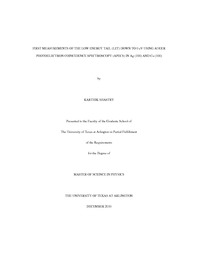
ATTENTION: The works hosted here are being migrated to a new repository that will consolidate resources, improve discoverability, and better show UTA's research impact on the global community. We will update authors as the migration progresses. Please see MavMatrix for more information.
Show simple item record
| dc.contributor.author | Shastry, Karthik | en_US |
| dc.date.accessioned | 2011-03-03T21:52:41Z | |
| dc.date.available | 2011-03-03T21:52:41Z | |
| dc.date.issued | 2011-03-03 | |
| dc.date.submitted | January 2010 | en_US |
| dc.identifier.other | DISS-10909 | en_US |
| dc.identifier.uri | http://hdl.handle.net/10106/5483 | |
| dc.description.abstract | We present the Auger Photoelectron Coincidence Spectroscopy (APECS) measurements of Ag (100) and Cu (100) over a full range of emitted energies from 0 eV to 81eV. The coincidence measurements were successful in separating the low energy Auger lines from a large background, arising from loss processes unrelated to the Auger transition. The measurements have revealed a well formed Auger peak at 60 eV for Cu (100) and an Auger peak at 40 eV for Ag (100) accompanied by a low energy tail (LET) associated with M2,3VV transition. The Low Energy Tail (LET) extends to 0 eV and has a broad maximum at 6eV in the case of Cu (100) and 10 eV in the case of Ag (100). The integrated intensity of the Low Energy Tail (LET) in Cu and Ag were 6 and 2 times larger than that of the Auger peak itself respectively. The origin of the LET is discussed in terms of extrinsic mechanisms in which electrons from the peak lose energy as they propagate to the sample surface, as well as intrinsic mechanisms in which multi-electron Auger processes distribute the energy gained by the filling of the core-hole to multiple valence electrons. | en_US |
| dc.description.sponsorship | Weiss, Alexander H. | en_US |
| dc.language.iso | en | en_US |
| dc.publisher | Physics | en_US |
| dc.title | First Measurements Of The Low Energy Tail (LET) Down To 0 eV Using Auger Photoelectron Coincidence Spectroscopy (APECS) In Ag (100) And Cu (100) | en_US |
| dc.type | M.S. | en_US |
| dc.contributor.committeeChair | Weiss, Alexander H. | en_US |
| dc.degree.department | Physics | en_US |
| dc.degree.discipline | Physics | en_US |
| dc.degree.grantor | University of Texas at Arlington | en_US |
| dc.degree.level | masters | en_US |
| dc.degree.name | M.S. | en_US |
Files in this item
- Name:
- Shastry_uta_2502M_10909.pdf
- Size:
- 1.504Mb
- Format:
- PDF
This item appears in the following Collection(s)
Show simple item record


